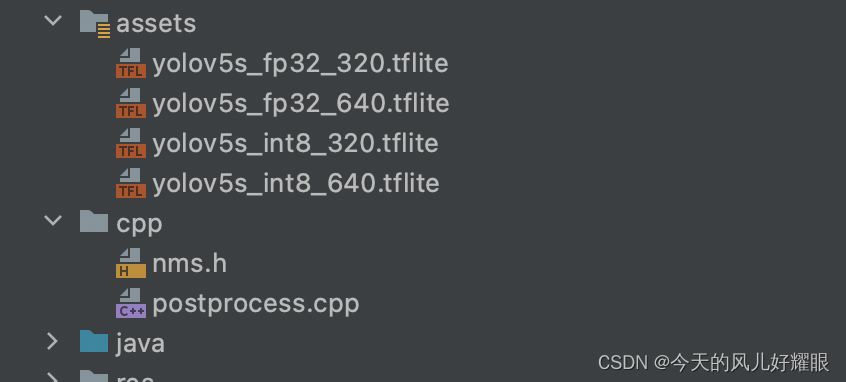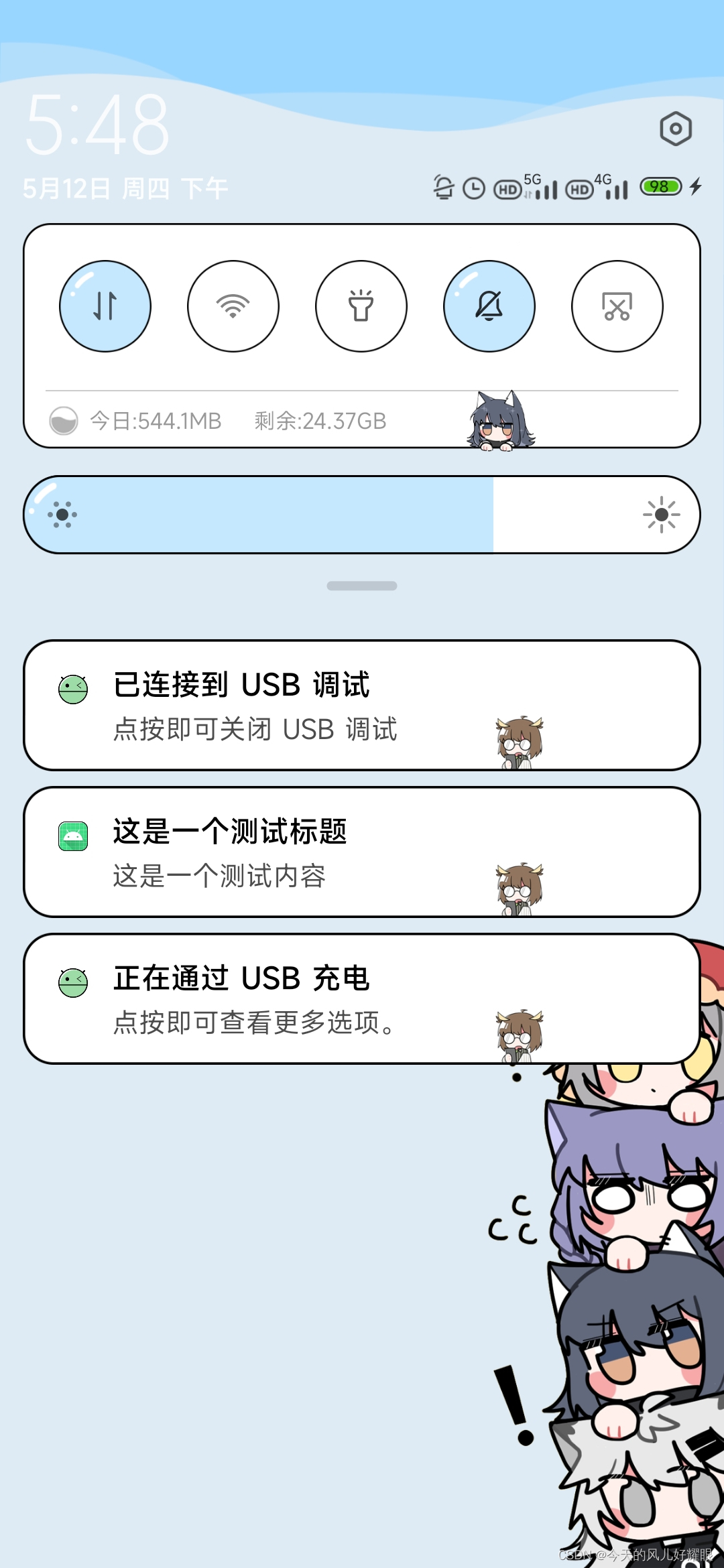热门标签
热门文章
- 1Unity开发——UGUI优化之图集的生成与运用_unity 创建图集
- 2基于javaweb jsp ssm电子竞技管理平台的设计与实现(源码+lw+部署文档+讲解等)
- 3按照CIS-Tomcat7最新基线标准进行中间件层面基线检测_cis安全标准 tomcat
- 4探索生成式AI的未来:Chat与Agent的较量与融合_aigc和agent的区别
- 5Linux中环境变量_linux环境变量是什么
- 64.UE数字人工程运行逻辑及程序逻辑_ue5 humen数字人及接口通信示例
- 7Hadoop入门学习笔记——五、在虚拟机中部署Hive_hive可以单独安装到一台虚拟机吗
- 8安装win11后电脑发热,升级win11电脑发热怎么办_win11升级后电脑发热
- 9对话系统中自然语言理解NLU——意图识别与槽位填充_意图识别,槽位抽取,nl2sql,语言大模型基本能力,rag
- 10在小公司做开发太难了!面试面到我心态爆炸..._进了家小公司,伦不到我开发
当前位置: article > 正文
安卓利用tensorflow-lite使用yolov5训练的模型_android yolov5 tensorflow
作者:一键难忘520 | 2024-07-13 07:21:04
赞
踩
android yolov5 tensorflow
前言
作为使用yolov5后一次简单的尝试
准备工作
- 通过yolov5训练出自己所需要的模型查看模型训练教程
- 将模型通过tensorflow的python版转换,使用yolov5 6.1以上版本
- 安卓端引入tensorflow远端依赖,并置入模型文件在项目工程里
这里我并没有去看tensorflow的api,而是直接参考了yolov5-android
注意事项
- 模型我全部用的是demo默认模型
- 运行demo时请打开悬浮窗权限
配置gradle
需要执行cmake来生成通过jni调用的资源
在app目录下的CmakeList.txt文本可以查看具体配置
这里不过多描述,只描述构建过程
远程引入tensorflow依赖
externalNativeBuild {
cmake {
path "CMakeLists.txt"
}
}
defaultConfig {......
ndk {
abiFilters 'armeabi-v7a', 'arm64-v8a'
}
}
dependencies {......
implementation 'org.tensorflow:tensorflow-lite:2.4.0'
}
- 1
- 2
- 3
- 4
- 5
- 6
- 7
- 8
- 9
- 10
- 11
- 12
- 13
迁移文件
将在modle_tflite下的文件夹复制到如下图所示
将在main/cpp的文件夹也复制到如下图所示

postprocess.cpp文件提供了供java调用的检测函数,这里可以去参考Tensorflow官方网站,是将结果通过jni给回调至客户端
编写悬浮窗
使用了XToast,我是以library形式引入工程的
执行录制屏幕代码
使用的是官方api,MediaProjection,感兴趣可以去查找相关资料
注意在安卓10级以上需要启动一个前台服务才可以使用
开启录屏部分代码
// 顶部初始化 private var mediaProjection: MediaProjection?=null private lateinit var projectionManager:MediaProjectionManager ...... // 点击事件请求开始录屏 binding.btnRecord.setOnClickListener { projectionManager =getSystemService(MEDIA_PROJECTION_SERVICE) as MediaProjectionManager val captureIntent= projectionManager.createScreenCaptureIntent(); startActivityForResult(captureIntent,20); } ...... // 和运行时权限申请一样,在onActivityResult回调里处理开始录屏事件 override fun onActivityResult(requestCode: Int, resultCode: Int, data: Intent?) { super.onActivityResult(requestCode, resultCode, data) if (requestCode == 20 && resultCode == RESULT_OK) { FloatUtil.showFloatWindow(application).apply { contentImageView = this } mediaProjection = projectionManager.getMediaProjection(resultCode, data!!); //执行查看视图函数 seeContent() } }
- 1
- 2
- 3
- 4
- 5
- 6
- 7
- 8
- 9
- 10
- 11
- 12
- 13
- 14
- 15
- 16
- 17
- 18
- 19
- 20
- 21
- 22
- 23
开启录屏后,需要用到另外一个东西,就是mediaProjection的createVirtualDisplay函数,其实就是VirtualDisplay,创建一个虚拟显示器。mediaProjection的使用(转载)和关于VirtualDisplay的使用
private fun seeContent() { mediaProjection?.apply { createDetector()//创建检测器 createImageReader() //创建imageReader registerCallback(object :MediaProjection.Callback(){ override fun onStop() { super.onStop() } },handler) //使用createVirtuaDisplay函数,需要制定名称,宽和高,dpi,显示模式,surface,剩余两个参数可以为null dispalyD = createVirtualDisplay("ScreenImageReader",640,640,1000 , DisplayManager.VIRTUAL_DISPLAY_FLAG_AUTO_MIRROR,imageReader.surface,object :VirtualDisplay.Callback(){ override fun onResumed() { super.onResumed() } override fun onPaused() { super.onPaused() } override fun onStopped() { super.onStopped() } },handler) } }
- 1
- 2
- 3
- 4
- 5
- 6
- 7
- 8
- 9
- 10
- 11
- 12
- 13
- 14
- 15
- 16
- 17
- 18
- 19
- 20
- 21
- 22
- 23
- 24
- 25
- 26
这里这里使用imageReader,imageReader它是包含一个surface的,并且它有一个setOnImageAvailableListener可以进行监听视图刷新,在刷新的时候去获取image对象,关于图片的边框添加和识别操作,可以看下面代码片段
/** * 图片更新 * 此处为回调函数 * 交由handler处理 */ override fun onImageAvailable(p0: ImageReader?) { //利用handler p0?.apply { val message = Message() message.what = 0xdd message.obj = this handlerDelayImage.sendMessage(message) handlerDelayImage.obtainMessage() } } /** * 开始截屏并识别 * 这个才是具体的处理函数 */ private fun startCacheAndSetInput(p0: ImageReader) { var nowImage:Image?=null try { nowImage = p0.acquireLatestImage() }catch (e:Exception){ nowImage = p0.acquireLatestImage() } nowImage?.apply { val width = 640 //可选 val height = 640 val planes = planes val buffer: ByteBuffer = planes[0].buffer val pixelStride = planes[0].pixelStride val rowStride = planes[0].rowStride val rowPadding = rowStride - pixelStride * width var bitmap: Bitmap = Bitmap.createBitmap(width + rowPadding / pixelStride, height, Bitmap.Config.ARGB_8888) bitmap.copyPixelsFromBuffer(buffer) //这就是初始截图 bitmap = Bitmap.createBitmap(bitmap, 0, 0, width, height) //开始检测 detector.setInput(bitmap) //获取到检测结果 val bboxes: List<TfliteRunner.Recognition> = detector.runInference() //绘制识别框到bitmap里 val resBitmap: Bitmap =ImageProcess.drawBboxes(bboxes, bitmap, 640) if (bboxes.size>0){ //对人点击 if (bboxes[bboxes.lastIndex].title=="person"){ if (!personClick){ //检测到人之后对人进行点击 //ScreenUtil.click(bboxes[bboxes.lastIndex].location.centerX(), bboxes[bboxes.lastIndex].location.centerY()) personClick = true //防止重复点击 } }else{ personClick = false } }else{ personClick = false } runOnUiThread { contentImageView?.apply { setImageBitmap(resBitmap) } } close() } }
- 1
- 2
- 3
- 4
- 5
- 6
- 7
- 8
- 9
- 10
- 11
- 12
- 13
- 14
- 15
- 16
- 17
- 18
- 19
- 20
- 21
- 22
- 23
- 24
- 25
- 26
- 27
- 28
- 29
- 30
- 31
- 32
- 33
- 34
- 35
- 36
- 37
- 38
- 39
- 40
- 41
- 42
- 43
- 44
- 45
- 46
- 47
- 48
- 49
- 50
- 51
- 52
- 53
- 54
- 55
- 56
- 57
- 58
- 59
- 60
- 61
- 62
- 63
- 64
- 65
- 66
- 67
- 68
- 69
- 70
- 71
- 72
- 73
关键使用类
悬浮窗 -FloatUtil
模型检测-TfliteRunner
首页-MainActitvity
边框绘制-ImageProcess
使用效果

最后github地址
yolov5结合tensflow在移动端的方案
本文内容由网友自发贡献,转载请注明出处:【wpsshop博客】
推荐阅读
相关标签



